Japrak is a traditional dish from Bosnia, Croatia, and Albania. In Herzegovina region it holds a special place and is a cherished part of the holiday cooking tradition. It’s simple, rich flavor wins over just about anyone who tries it.
Similar to sarma, japrak is made with young grape vine leaves stuffed with ground meat, rice, and spices. Our recipe features it covered in tomato sauce and baked in the oven. It’s a tasty, cozy, home-cooked meal with a distinctly local character. And it’s easier than you think to make it at home.
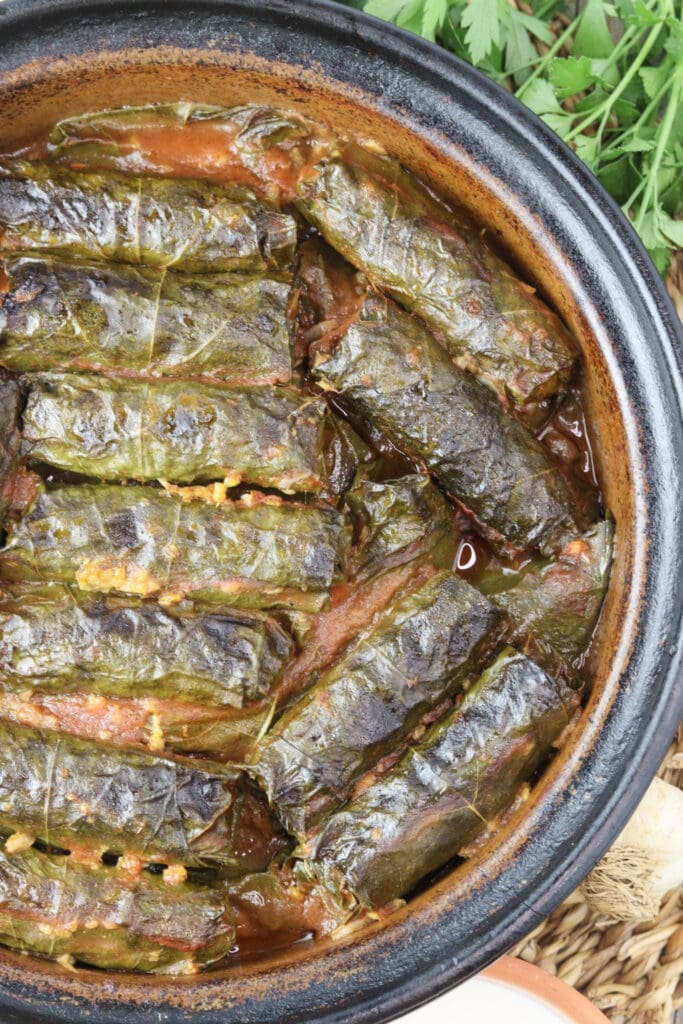
Japrak – delicious Bosnian stuffed grape vine leaves
Like many traditional dishes from Bosnia and Herzegovina—such as tufahije, kljukusa, and sataras—japrak is another meal shaped by Turkish cuisine, which spread through the Balkans during the time of the Ottoman Empire and the conquest of Bosnia.
Japrak (or yaprak in Turkish) literally means “leaf.” Across the Balkans, the dish goes by different names—japrak, dolma, or even “summer sarma”—but they all refer to some version of stuffed leaves. Almost every region has its own take on it. In Herzegovina, it’s usually made with raštika (Brassica oleracea), a local type of leaf cabbage, or with young grape vine leaves.
In early summer, from the beginning of May to mid-June, japrak is made with fresh, young grape leaves. To enjoy it throughout the year, grape leaves are often preserved in brine. The young leaves are blanched in salted water, then packed into glass jars and covered with salted water.
In the Muslim regions of Bosnia and Herzegovina, japrak is usually made with a mix of ground beef and lamb. In areas where other religions are more common, the filling often includes ground beef and pork, and sometimes a bit of smoked bacon for extra flavor.
There are several regional variations of japrak across Bosnia and Herzegovina. In his cookbook Bosanski kuhar, Alija Lakišić describes a few unique versions: japrak from Bihać is served with melted butter and lemon juice, while the one from Travnik is topped with creamy homemade kajmak.
There’s also a version where grape leaves are stuffed along with red peppers, eggplants, and smoked beef. Another variation, called jalan-sarma (or “fake sarma”), is a lighter vegetarian version made with rice, mint leaves, and parsley instead of meat.
Our version of japrak uses tender young grape vine leaves, stuffed with a mix of ground beef and pork. The little green packets are arranged in a baking dish, covered with tomato sauce, and baked with a lid on.
The result is a comforting, sarma-style dish that pairs well with sides like potatoes, rice, or polenta—or simply enjoyed warm with a slice of homemade corn bread.
We hope this becomes one of those recipes you’ll come back to again and again!

The ingredients
GRAPE LEAVES – Use young grapevine leaves, since older ones can be tougher and a little bitter. If you want to make japrak outside of grape leaf season, check the end of the post for how to preserve them.
GROUND MEAT – We used a mix of ground beef and pork. Traditional japrak is often made with beef and lamb, but you can use whatever you prefer. Adding a bit of smoked meat can also give it a nice, rich flavor.
RICE – Organic white rice goes into our filling, but it’s easy to switch things up with brown rice, buckwheat groats, or bulgur if you prefer.
TOMATO SAUCE – Making your own from fresh tomatoes is always a good idea if you have the time!
AN ONION – One chopped onion goes into the filling to add sweetness and aroma. You can also toss in another one when making the tomato sauce, if you like.
GARLIC – A must-have. Garlic goes into both the filling and the sauce for a rich, deep flavor.
OLIVE OIL – You can use vegetable oil instead, or even better, lard, if you want a more traditional touch.
FRESH PARSLEY – A handful of chopped parsley goes into the meat mix. It adds a fresh, herby note that really lifts the dish.
PAPRIKA – Sweet paprika brings a warm color and gentle flavor to the filling.
SALT & BLACK PEPPER – Season to your taste. You can also add herbs like marjoram or rosemary if you want to play around with the flavor.
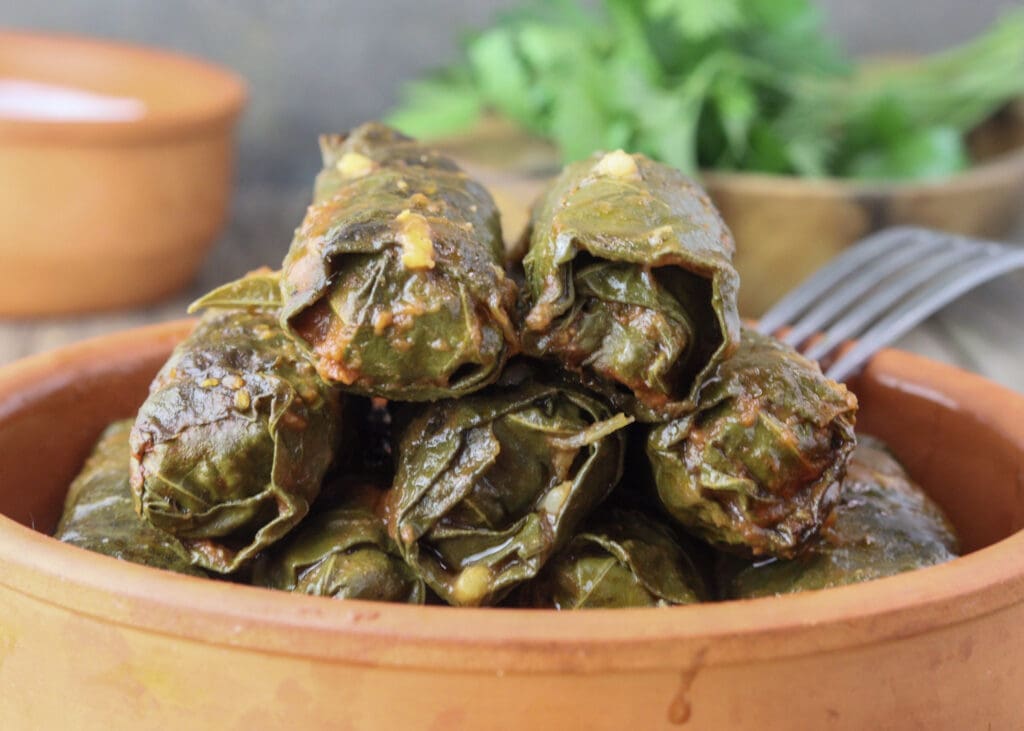
How to make japrak
STEP 1: Preheat the oven to 392°F (200°C). Rinse the grapevine leaves and bring a pot of water to a boil. Meanwhile, soak the rice in a bowl of water for about 20 minutes.
STEP 2: Once the water is boiling, quickly dip the grape leaves in for about 1 minute on each side. Take them out and set aside to cool.
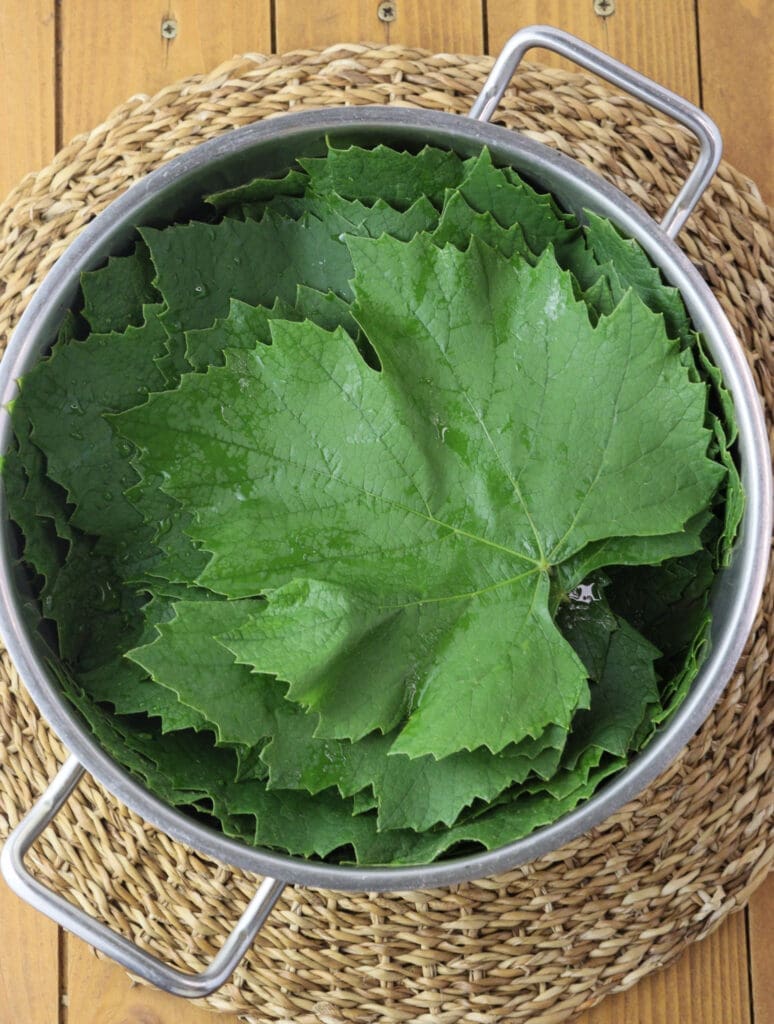
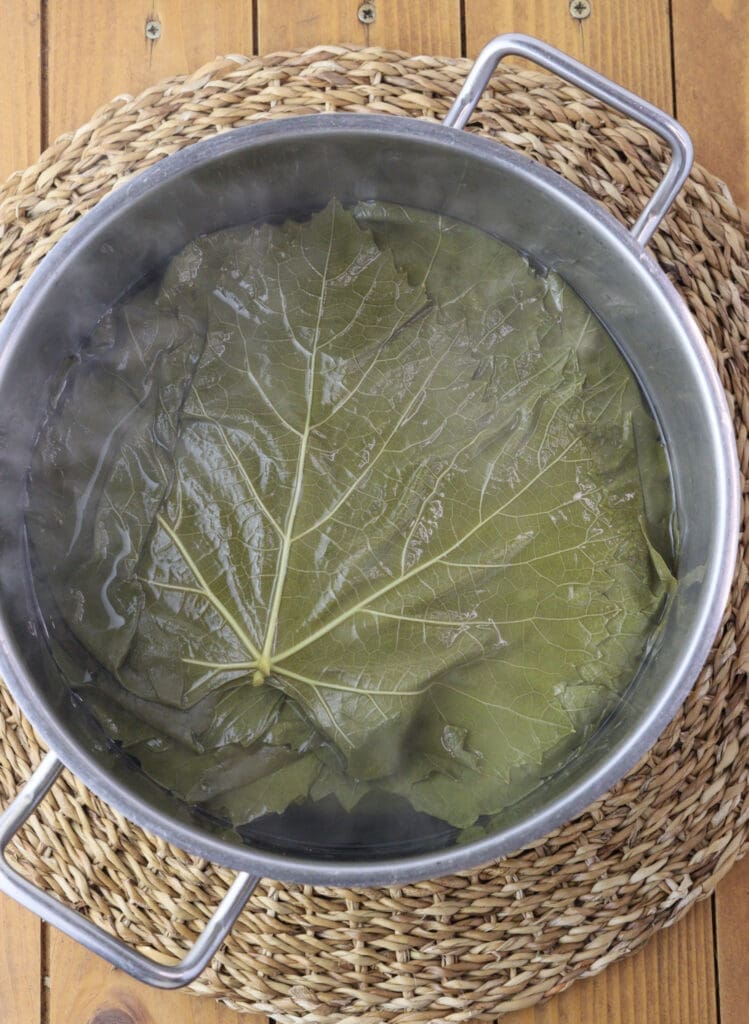
STEP 3: While the leaves are cooling, finely chop 3 cloves of garlic and one onion for the filling. If you’re a garlic lover like me, feel free to toss in a little extra!
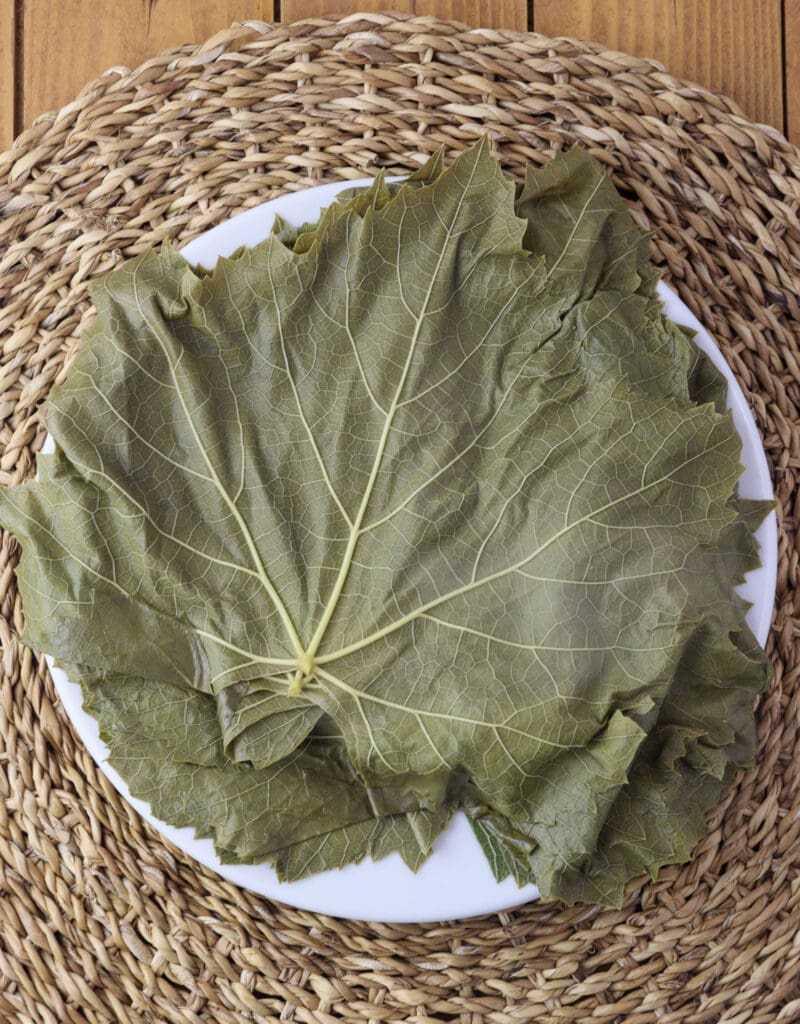
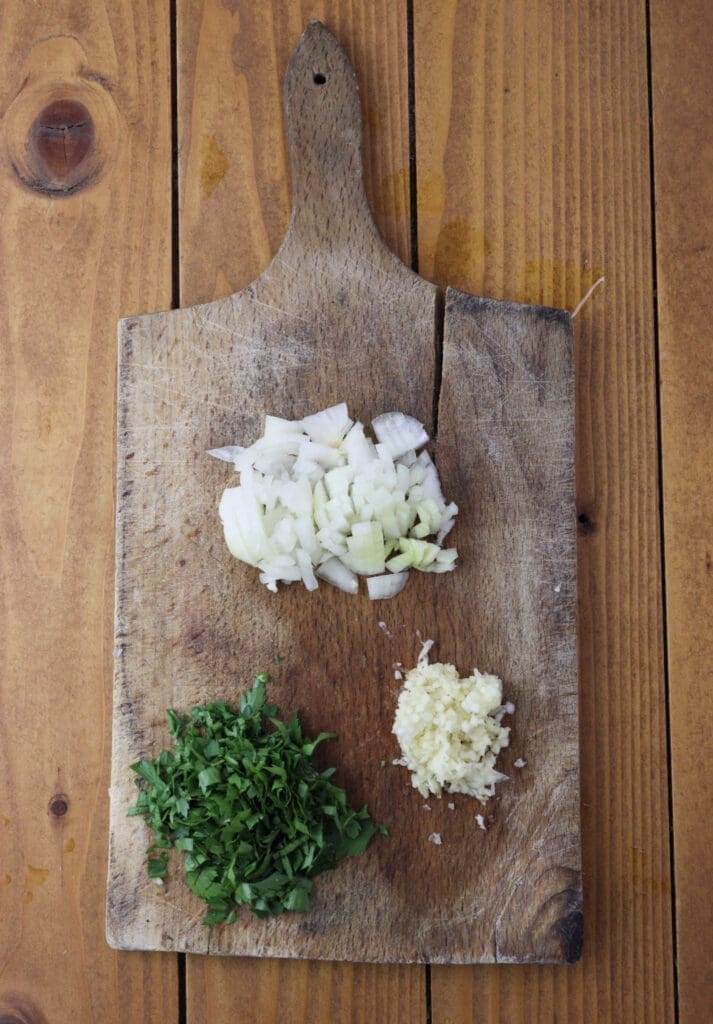
STEP 4: In a large bowl, mix together the ground meat, soaked rice, chopped garlic and onion, parsley, salt, black pepper, and sweet paprika.
STEP 5: Mix everything thoroughly so the herbs and spices really soak into the meat. The best way to do this is with your hands—just get in there and work it all together.
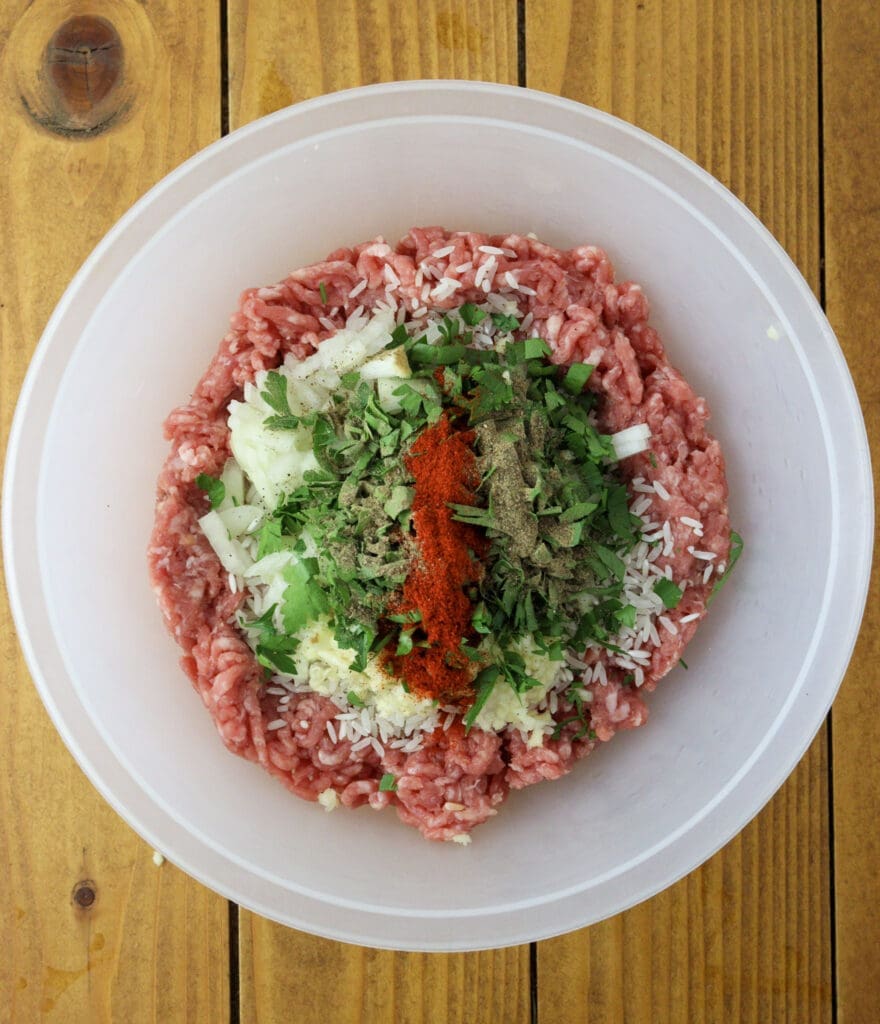

STEP 6: Now it’s time to start stuffing the vine leaves. Place about a tablespoon of the meat mixture onto each leaf—just enough to roll it up without overstuffing.
Place the filling in the center of the leaf, then fold the bottom up over it and tuck in the sides. Keep rolling it up until you get a neat little cigar-shaped bundle. Don’t roll too tightly—the rice will expand as it cooks.
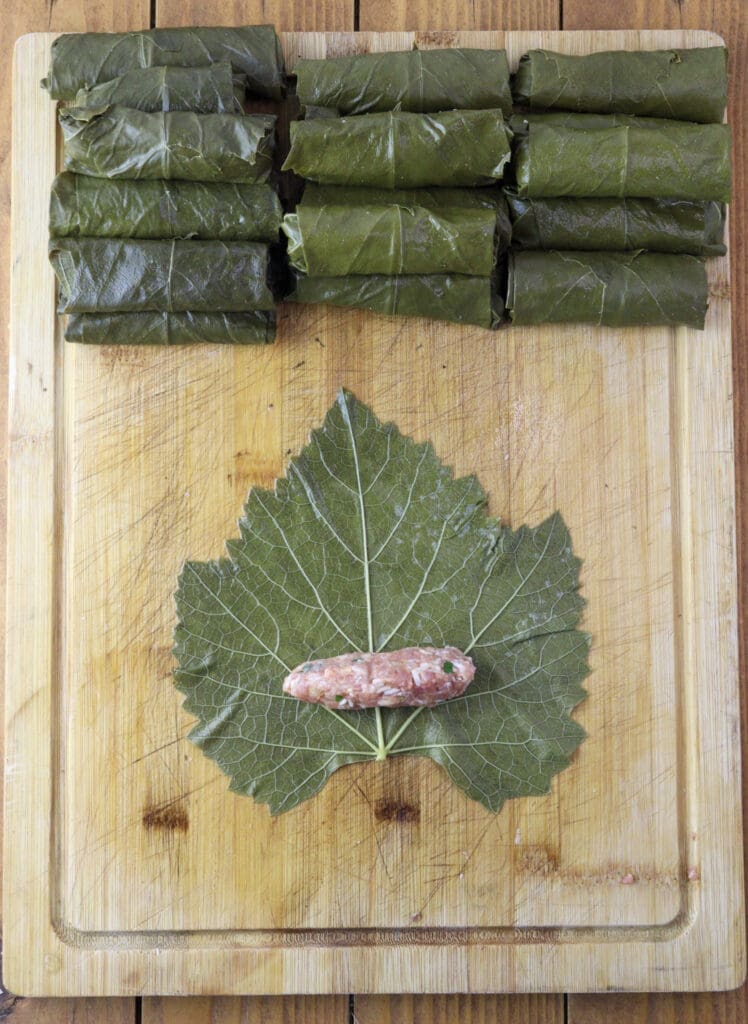
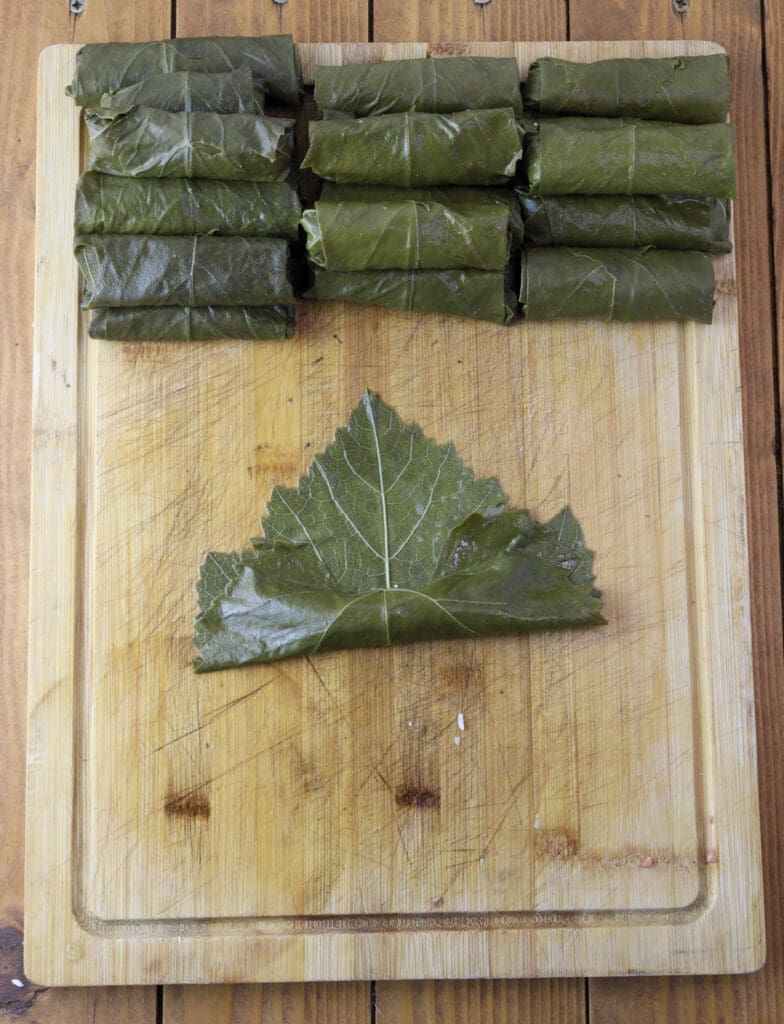
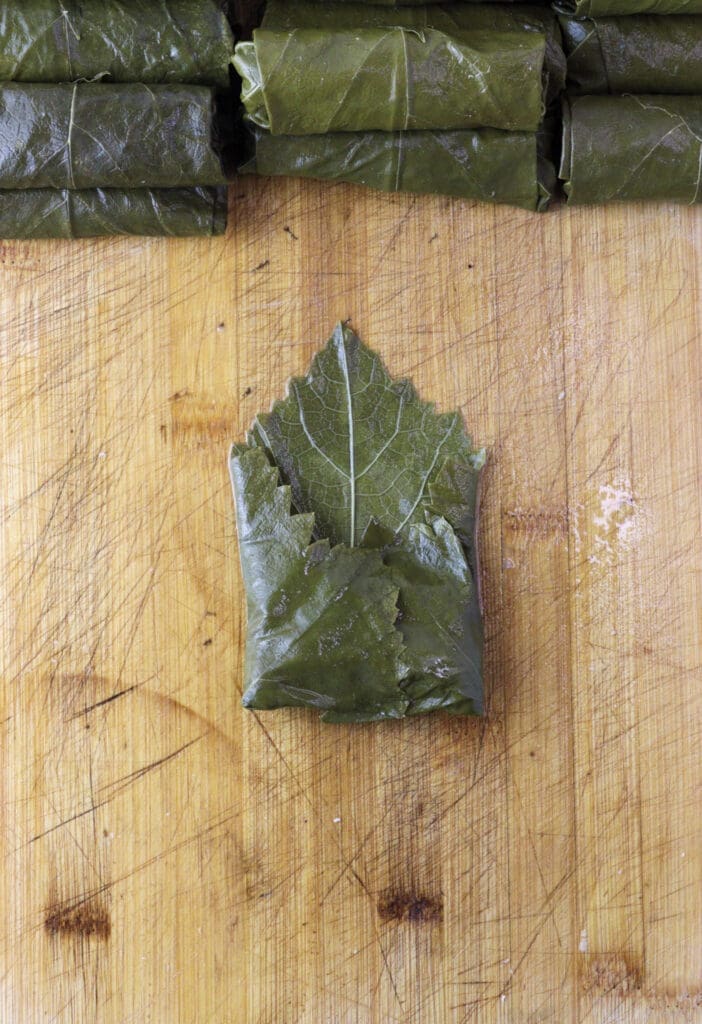
STEP 7: Arrange the rolled japraks snugly in a greased baking pot, but leave a little space between them so the sauce can flow in and around each one.
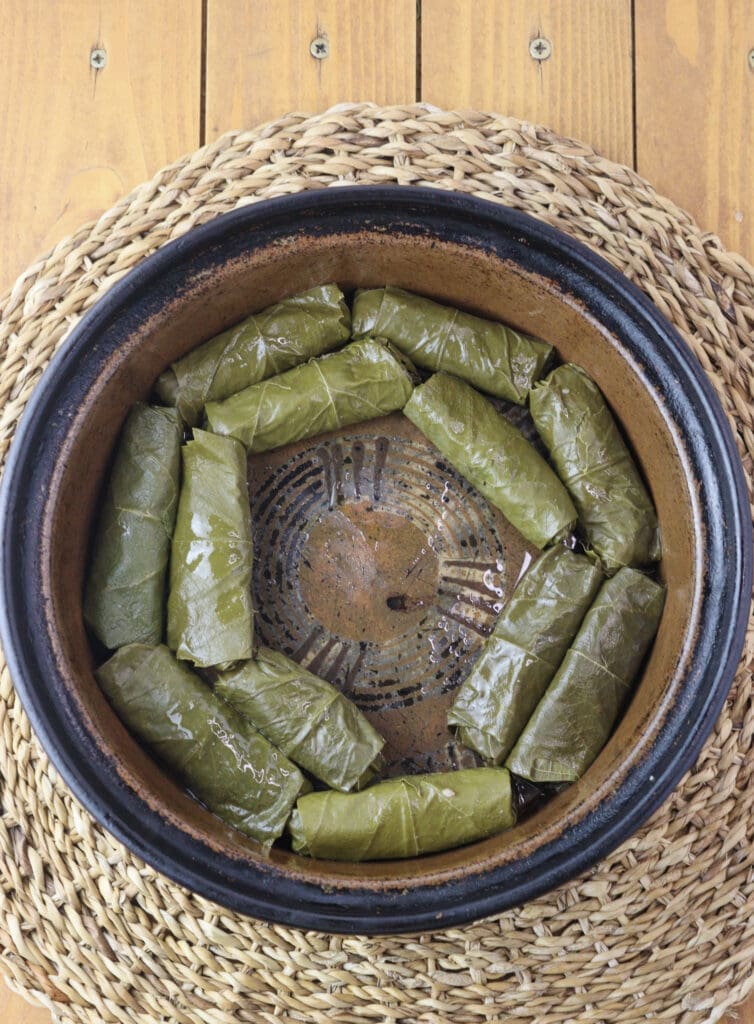
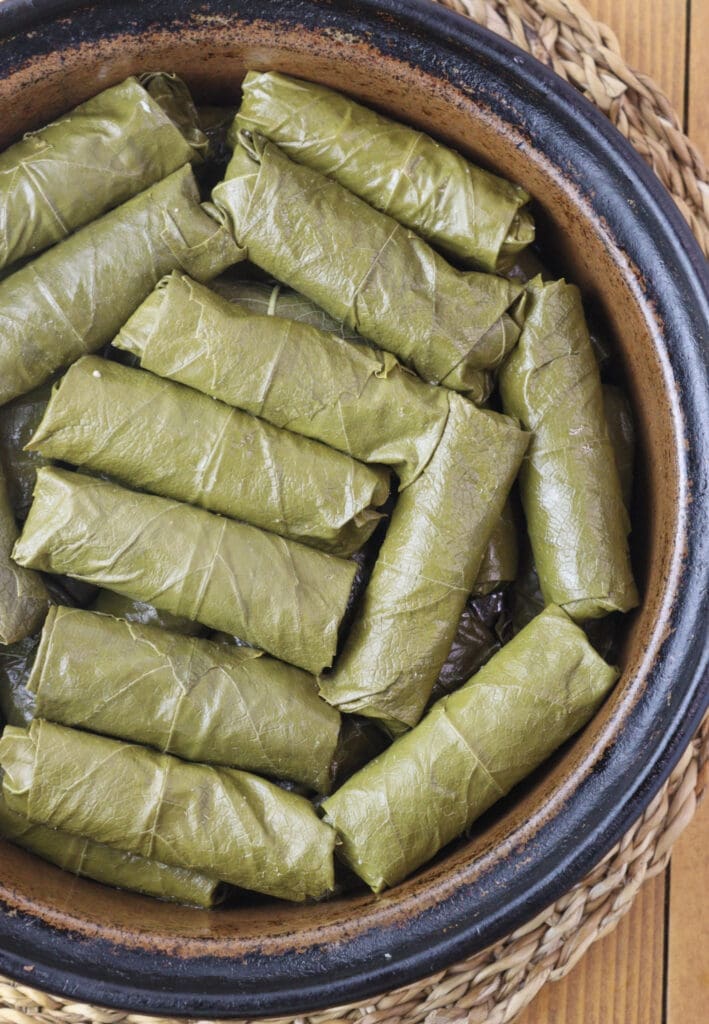
STEP 8: In a separate saucepan, quickly sauté the remaining garlic in a bit of oil over medium heat. Add the tomato sauce and one cup of water, then season with salt and black pepper. No need to cook the sauce—it’ll finish in the oven. Just pour it evenly over the rolled leaves in the pot.
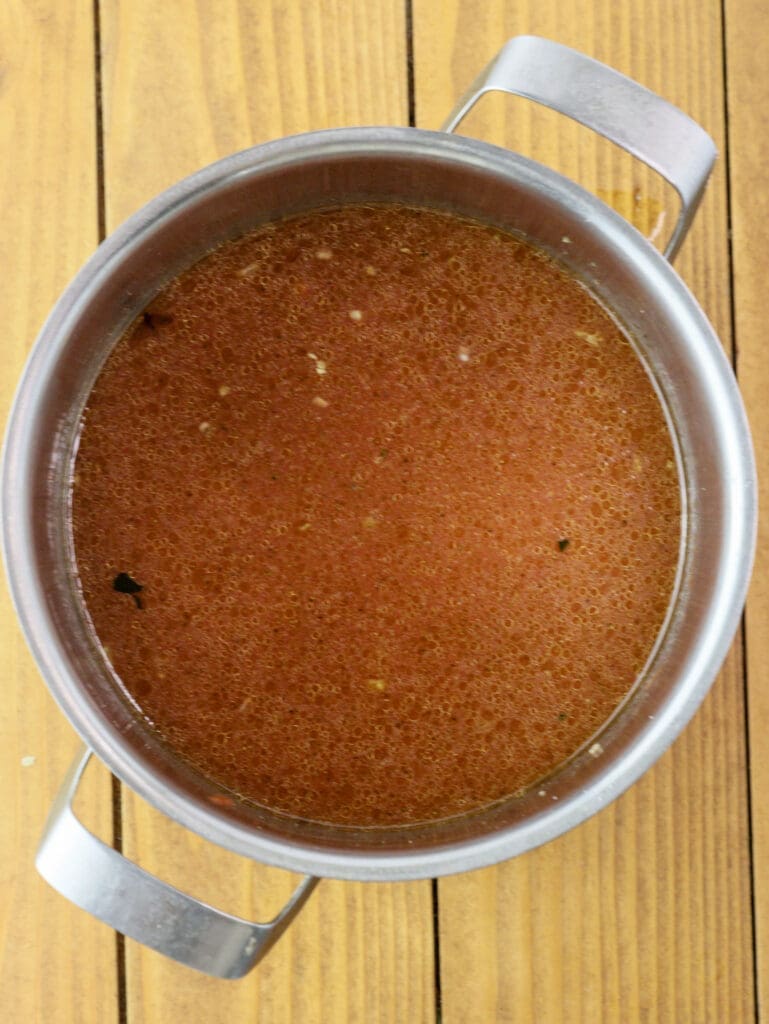
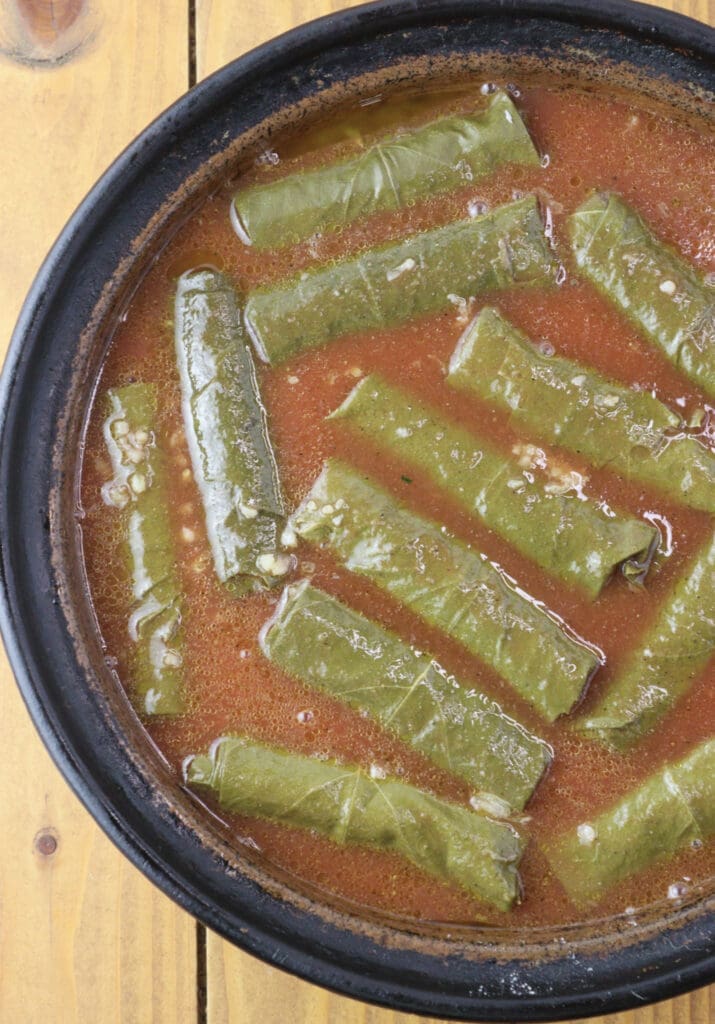
STEP 9: Cover the baking dish and bake at 200°C (392°F) for 30 minutes. Then, remove the lid and bake for an additional 15 minutes, allowing the tops to brown slightly and the sauce to thicken.
And that’s it! Your delicious japrak is ready to serve—warm, fragrant, and perfect with your favorite side or just a slice of fresh bread. Enjoy!
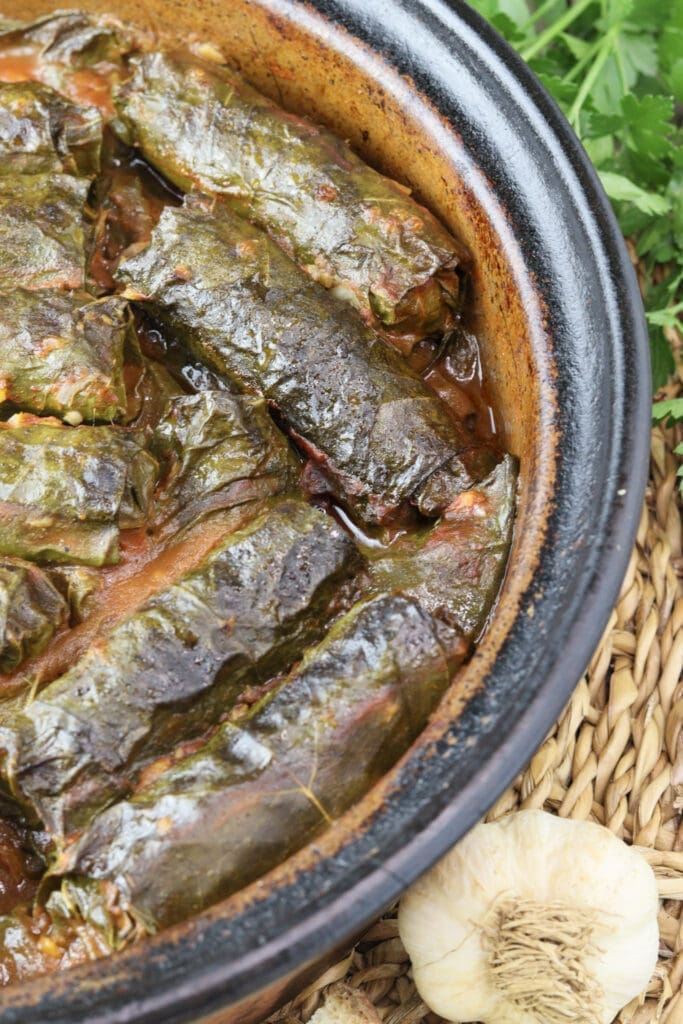
Tips worth remembering
- Use younger leaves. Young grapevine leaves are tender and easier to roll. Avoid older leaves—they can be tough and bitter, even after blanching.
- Don’t overfill. Stick to about a tablespoon of filling per leaf. Too much, and they’ll be hard to roll or might burst during cooking.
- Leave the room for the rice to expand. When rolling, don’t pack them too tightly. The rice needs space to swell as it cooks.
- Layer tightly, but not crammed. Arrange the rolls close together in the pot so they hold their shape, but don’t squish them too tightly—you want the sauce to reach every corner.
- Leftovers reheat well. Japrak keeps beautifully in the fridge for a few days and can be reheated in the oven.
- Add wine to the sauce. This will gently deepen the flavor and aroma, while the alcohol will cook off during baking.
- Serving ideas: Try it with mashed potatoes, polenta, rice, or fresh corn bread. A dollop of kajmak or sour cream on top is never a bad idea! Finish the meal with tufahije (stuffed apples) and pair with a glass of dry white wine.
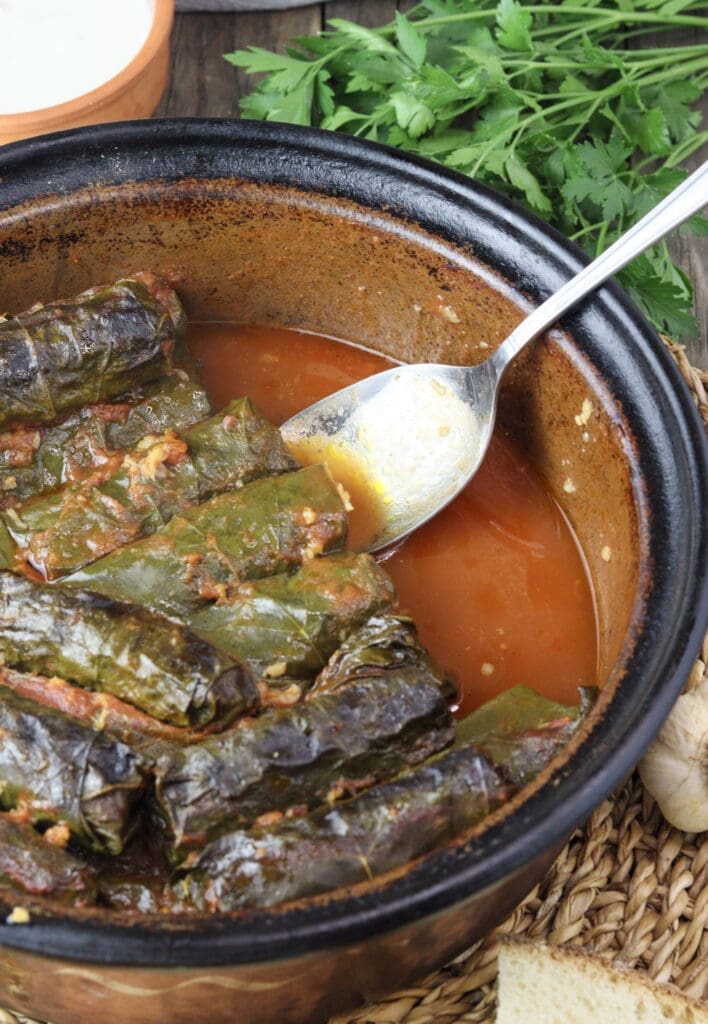
Japrak variations
Vegan japrak – swap the meat for a mix of cooked buckwheat groats and beans—a hearty, filling combo that tastes excellent baked in the tomato sauce. Add garlic, onion, parsley, and your favorite spices as usual.
Vegetarian japrak – Use a mix of cooked rice, grains, lentils, beans, sautéed mushrooms, tofu, or finely chopped veggies in place of the meat. You can combine a few for more texture and flavor—don’t forget the herbs!
Keto japrak – Skip the rice altogether and make stuffed vine leaves with just ground meat and a couple of eggs to bind it all together. You’ll love it!
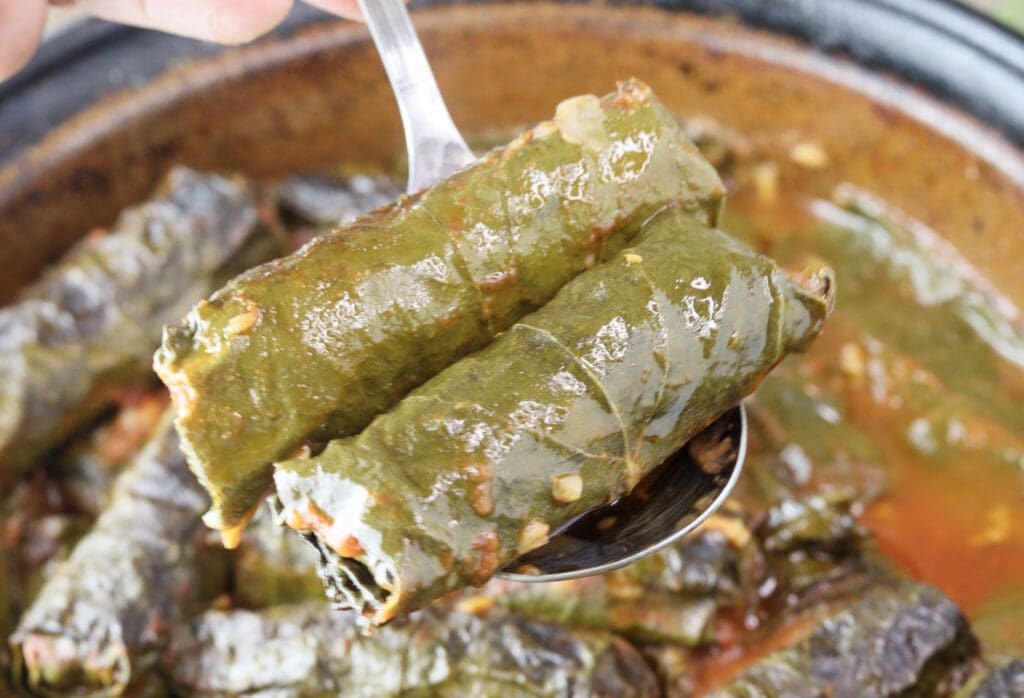
How to preserve grape leaves to make japrak in winter
Rinse the grape leaves well under cold water to wash away any dust or tiny bugs.
Lay them flat, stack about 15 leaves at a time, and roll them up loosely—like a soft cigar.
Bring water to a boil with one tablespoon of salt per liter, then quickly blanch the leaf rolls in the hot water.
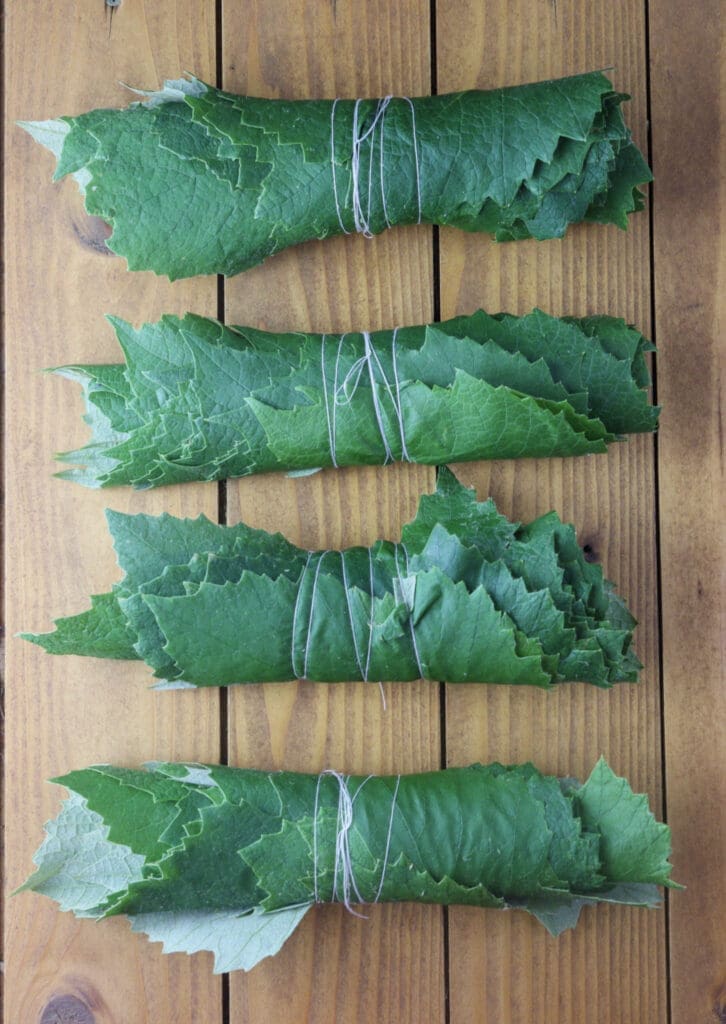

Let it cool until it’s just slightly warmer than room temperature. Pack the blanched leaves into clean, sterilized glass jars, then pour the cooled brine over them until they’re fully covered. Seal the jars and store them in a cool, dark place.
It’s so joyful having a stash of preserved grape leaves—ready for a cozy pot of japrak any time of year!
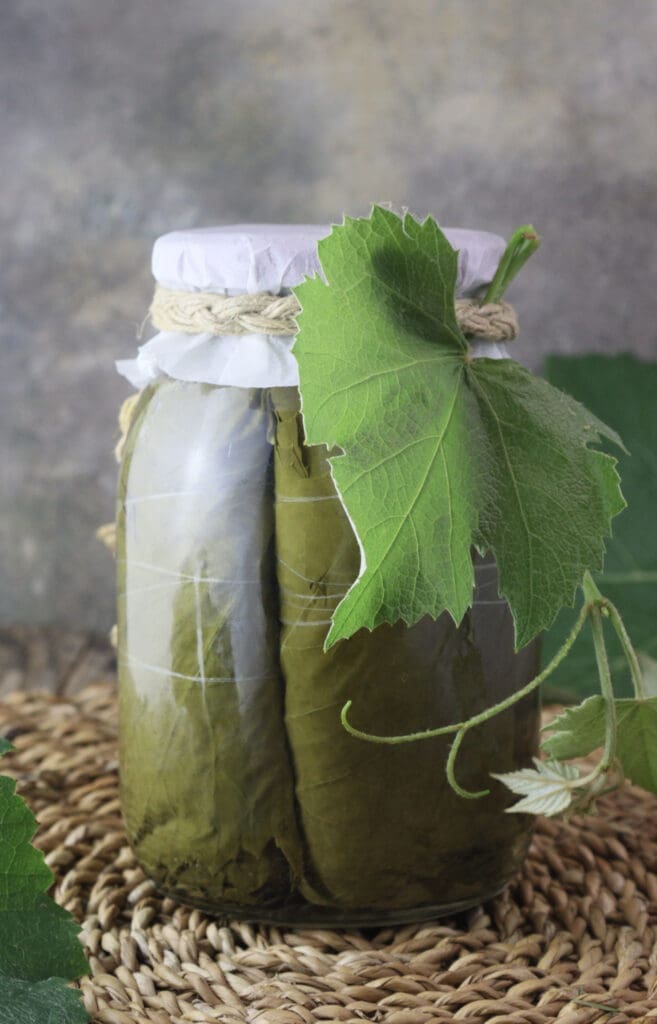
Japrak FAQs
Japrak keeps well in the fridge for 2 to 3 days. It also freezes beautifully—just pack it into smaller freezer bags so you can take out only what you need. It will stay good in the freezer for up to three months. To serve, thaw it in the fridge overnight and reheat gently (in a covered pot) in the oven.
The terms dolma and japrak are often used for similar dishes, and the difference mostly comes down to regional language and tradition. Dolma is a broader Turkish word that means “stuffed” and can refer to vegetables such as peppers, eggplants, or grape leaves filled with rice or meat. Japrak (from the Turkish yaprak, meaning “leaf”) specifically refers to stuffed grape leaves. In the Balkans, japrak typically refers to rolled grape leaves with a meat or rice filling, often baked in a tomato sauce. So while all japrak are a kind of dolma, not all dolma are japrak!
Japrak isn’t ideal for traditional canning, like jams or pickles, because it contains meat and requires precise pressure canning to be safely preserved. However, you can preserve the grape leaves themselves (see our tips above), then make fresh japrak anytime.
Bosnian food you might like
Do you want to try more comforting dishes from Bosnian cuisine? We made a crispy-baked kljukusa potato pie, delicious stuffed poached apples tufahije, and the colorful vegetable stew sataras. For something a little different, try our black trumpet mushroom jam. Pair your meal with a slice of soft Projara polenta bread or warm ustipci and delicious homemade kajmak, or dive into baked goodies like phyllo cabbage pie and cottage cheese rolls. Prijatno!
Japrak – Baked Stuffed Grape Leaves in Tomato Sauce
EQUIPMENT
- 1 baking pot with a lid
INGREDIENTS
- 30 grape vine leaves
- 500 g ground meat
- 130 g rice
- 300 g tomato sauce
- 1 onion
- 8 cloves garlic
- 2 tbsp olive oil
- 1 tsp sweet paprika
- fresh parsley
- 1.5 tsp salt
- 1 tsp black pepper
INSTRUCTIONS
- Preheat the oven to 200°C (392°F). Rinse the grapevine leaves and bring a large pot of water to a boil. While you wait, soak the rice in water for about 20 minutes.
- Once the water is boiling, dip the grape leaves in for about 1 minute on each side. Take them out and let them cool.
- While the leaves are cooling, finely chop 3 garlic cloves and 1 onion. If you love garlic, feel free to add more.
- In a large bowl, mix together the ground meat, soaked rice, chopped onion and garlic, parsley, salt, black pepper, and sweet paprika.
- Mix everything really well. Ensure the herbs and spices blend into the meat evenly.
- Spoon about 1 tablespoon of filling into the center of each grape leaf. Fold the bottom over the filling, tuck in the sides, and roll it up like a small cigar. Don’t roll too tightly, as the rice will expand while cooking.
- Place the rolled japraks into a greased baking dish. Pack them in snugly, but leave a little space for the sauce to spread around them.
- In a small pan, sauté the remaining garlic in a little oil. Add the tomato sauce, 1 cup of water, salt, and pepper. You don’t need to cook the sauce—just pour it over the japrak in the dish.
- Cover the dish and bake for 30 minutes. Then uncover and bake for another 15 minutes until the tops are slightly browned and the sauce has thickened.
- Serve warm with bread, mashed potatoes, polenta, or your favorite side. Enjoy!
NOTES
NUTRITION
If you liked our japrak recipe, please give it a rating in the comments below. We appreciate it!
We’re excited to share that our recipe was featured over at Fiesta Friday and Creative Jewish Mom.
Show your love by sharing ❤️



This recipe sounds amazing! We are so happy that you have been sharing your wonderful recipes with us at The Crazy Little Lovebirds link party. 🙂
I’m really happy that you liked it!
Not for me I’m afraid but recipe passed onto husband. Thanks for sharing with #pocolo